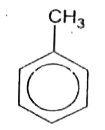Find the number of water of crystallizations in (A) :-
4
5
10
24
The correct Answer is:C
To solve the problem, we need to analyze the two reactions provided and determine the number of water molecules of crystallization in the hydrated salt (A).
1. Identify the Compounds in the Second Reaction:
The second reaction involves heating boric acid (H₃BO₃). Upon strong heating, it produces two compounds, which we will denote as C and D.
- Reaction:
H3BO3strongly heated−−−−−−−−−→C+D
2. Determine the Products of the Second Reaction:
When boric acid (H₃BO₃) is heated, it decomposes to form metaboric acid (HBO₂) and water (H₂O). The balanced equation is:
2H3BO3strongly heated−−−−−−−−−→HBO2+H2O
Further heating of metaboric acid (HBO₂) leads to the formation of boric anhydride (B₂O₃) and more water. The balanced equation for this step is:
2HBO2strongly heated−−−−−−−−−→B2O3+H2O
Thus, we find that:
- C = B₂O₃ (boric anhydride)
- D = H₂O (water)
3. Identify the Compounds in the First Reaction:
The first reaction involves a hydrated salt (A) that, when heated strongly, produces two compounds (B and C). We know from the previous step that C is B₂O₃.
- Reaction:
Astrongly heated−−−−−−−−−→B+C
4. Determine the Hydrated Salt (A):
The hydrated salt (A) is likely sodium tetraborate decahydrate, which has the formula Na₂B₄O₇·10H₂O. When this compound is heated, it produces sodium metaborate (NaBO₂) and boric anhydride (B₂O₃).
- Balanced Equation:
Na2B4O7⋅10H2Ostrongly heated−−−−−−−−−→2NaBO2+B2O3+10H2O
Here, we can see that the number of water molecules of crystallization in (A) is 10.
5. Conclusion:
The number of water of crystallization in the hydrated salt (A) is 10.
Final Answer:
The number of water of crystallization in (A) is 10.
---
The second reaction involves heating boric acid (H₃BO₃). Upon strong heating, it produces two compounds, which we will denote as C and D.
H3BO3strongly heated−−−−−−−−−→C+D
When boric acid (H₃BO₃) is heated, it decomposes to form metaboric acid (HBO₂) and water (H₂O). The balanced equation is:
2H3BO3strongly heated−−−−−−−−−→HBO2+H2O
Further heating of metaboric acid (HBO₂) leads to the formation of boric anhydride (B₂O₃) and more water. The balanced equation for this step is:
2HBO2strongly heated−−−−−−−−−→B2O3+H2O
Thus, we find that:
- C = B₂O₃ (boric anhydride)
- D = H₂O (water)
The first reaction involves a hydrated salt (A) that, when heated strongly, produces two compounds (B and C). We know from the previous step that C is B₂O₃.
Astrongly heated−−−−−−−−−→B+C
The hydrated salt (A) is likely sodium tetraborate decahydrate, which has the formula Na₂B₄O₇·10H₂O. When this compound is heated, it produces sodium metaborate (NaBO₂) and boric anhydride (B₂O₃).
Na2B4O7⋅10H2Ostrongly heated−−−−−−−−−→2NaBO2+B2O3+10H2O
Here, we can see that the number of water molecules of crystallization in (A) is 10.
The number of water of crystallization in the hydrated salt (A) is 10.
The number of water of crystallization in (A) is 10.
Topper's Solved these Questions
- INORGANIC CHEMISTRYBOOK - ALLENCHAPTER - INORGANIC CHEMISTRYEXERCISE - s-BLOCK ELEMENTS
21 Videos
- INORGANIC CHEMISTRYBOOK - ALLENCHAPTER - INORGANIC CHEMISTRYEXERCISE - METALLURGY
22 Videos
- INORGANIC CHEMISTRYBOOK - ALLENCHAPTER - INORGANIC CHEMISTRYEXERCISE - COORDINATION COMPOUNDS & d-BLOCK COMPOUNDS (MATCH THE COLUMN)
2 Videos
- HYDROGENBOOK - ALLENCHAPTER - HYDROGENEXERCISE - EXERCISE-5
17 Videos
- Ionic EquilibriumBOOK - ALLENCHAPTER - Ionic EquilibriumEXERCISE - All Questions
37 Videos
Similar Questions
underset(("Hydrated salt"))((A)) underset("heated")overset("Storngly")tounderset("glassy bead")underset("transparent")ubrace(B+C)
H3BO3Strongly−−−−→heatedC+D
Identify C-
View Solution(A)(Hydrated salt)Storngly−−−−→heatedB+Ctransparentglassy bead
H3BO3Strongly−−−−→heatedC+D
Find the number of tetrahedral and trigonal planar units in structure of A -
View Solution
Knowledge Check
CH3−CH3∣C∣CH3−C∣BrH3Major product (A) is CH3−EtoH−−→Δ(A)
A B
B C
C D
D
Phenol Zn-dust−−−→AConc.HNO3−−−−−−→+H2SO4BZn−−−→NaOHC
in the above reaction A, B and C are :Abezene,nitrobenzene and anilineBbenzene , dinitrobenzene and m-nitroanilineCbenzene, nitrobenzene and hydrazobenzeneDtoluene, m-nitrobenzene nd m-toludine
(A)(Hydrated salt)Storngly−−−−→heatedB+Ctransparentglassy bead
H3BO3Strongly−−−−→heatedC+D
How many X–O–X linkages are present in structure of A (X = central atom)-
View SolutionCH3−CH3∣C∣CH3−C∣BrH−CH3El mechanism−−−−−−−−−−→Δ(A)
Major product (A) is
View Solution Br2−−→hv(A)1.KCN−−−−−−−→2.H3O,heat(B)
Br2−−→hv(A)1.KCN−−−−−−−→2.H3O,heat(B)
Calculate no. of carbons in B−−−−−−−−−−−−−−−−→Degree of unsaturation in B
View SolutionIdentify the product A,B,C and D
C6H6CH3Cl−−−−−−−−→Anhyd. AlCl3ACrO2Cl2−−−−→CCl4BConc.−−−→NaOHC+D.
View Solution2CH3−C∣∣O−CH3Mg/Hg−−−−→H+ Product in the reaction is
View SolutionComplete the reaction :
C6H5COONasodalime−−−−−−−→heatAC2H5Cl−−−−−−→AlCl3B
View Solution
